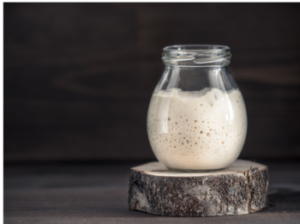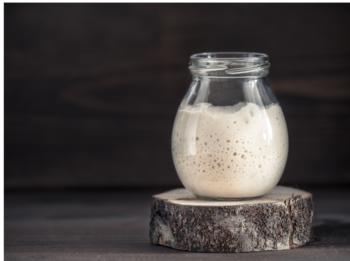
Most of us loved fresh, puffy baked goods, with their warm, soft texture or meringues that are at once fluffy, chewy, and crunchy.
Where does this pillowy texture come from? The answer is simple: bubbles.
Carbon dioxide bubbles + a protein matrix is the key to creating a light, risen baked good.

Breads, rolls, muffins, cakes, and meringues all rely on some form of leavening agent. This leavening agent creates air- or carbon dioxide-filled bubbles that cause the dough or batter they’re in to puff and rise. In all cases, these air bubbles have to be trapped in some form of protein matrix – usually gluten from wheat or the protein-rich whites of eggs. Because it is so elastic, gluten can hold large bubbles and create a lighter final product. Doughs made with other types of grain that are gluten free, tend to be more flat and dense because the existing proteins in the dough are not elastic enough to hold bubbles.
Leavening agent | What it is | How it works | Other notes |
Baker’s yeast | Yeast is a living organism that feeds on moisture and sugar. | The yeast consumes and ferments the sugar present in a batter or dough and produces carbon dioxide bubbles. | Yeast fermentation creates a distinct taste in breads, cakes and donuts. Yeast fermentation does take more time to leaven doughs and batters than other types of leavening. |
Baking soda | This dry white powder is made up of sodium bicarbonate. | Baking soda needs an acid such as vinegar or lemon juice to make it react and start to form carbon dioxide bubbles. | Baking powder’s leavening is almost immediate, which is why breads made using it are called “quick breads”. |
Baking powder | Is a dry white powder made up of carbonate or bicarbonate, a weak acid and cornstarch or other base that keeps the acid neutralized until it’s wet. | When combined with liquid, baking powder reacts and creates carbon dioxide bubbles. | Baking powder’s leavening is almost immediate, which is why breads made using it are called “quick breads”. |
Egg whites | Egg whites contain 56% of the protein in an egg, but none of the fat. | When an egg white is beaten and air gets whipped into it, the protein in the egg white forms a matrix that holds the air bubbles in place. The result is a light, foamy mixture that can be folded into batters to add air and leaven the batter. | Using egg whites for leavening can be a bit more fussy than other forms of leavening but it is also the only way to produce a cloudlike angel-food cake or meringues. |
Carbonated water or beverages | Carbonated beverages are filled with carbon dioxide bubbles. | Adding a carbonated liquid to a batter or dough will automatically add carbon dioxide to the mix that can form bubbles and leaven the batter or dough. | This form of leavening is almost immediate and very convenient. |
Introducing ...Sunny Gold Sweet Mustard Pickles! Dismiss